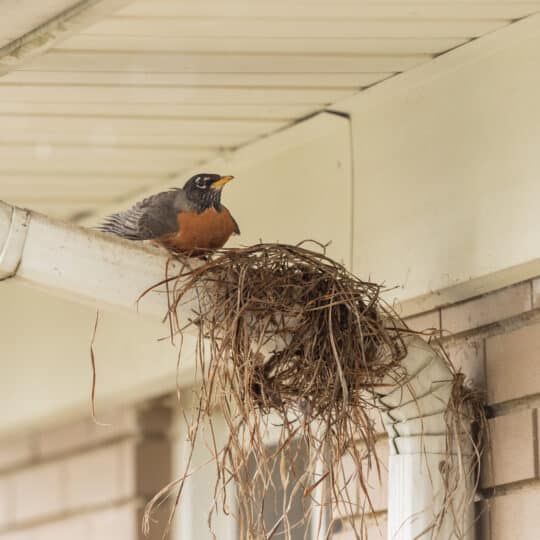Nesting Bird Damage
5 Potential Risks and Prevention Methods

Just as spring brings blooming flowers and warm rain showers, the air is also filled with birdsong. While this may be lovely to listen to, it may also mean these beautiful birds are making a mess of your gutters, eaves, and patio awnings with their nests. Learn what kind of nesting bird damage can occur in your yard and how to prevent it from happening.
Where Birds Nest and Why
Like any expecting parent, birds seek out sheltered locations to safely build a nest for their young. These areas are typically near food sources and tucked away from predators. Since they may be looking for these spaces before trees have fully leafed, sometimes they’re drawn to protected structures such as eaves, vents, chimneys, and gutters around your home or office. While this may be an ideal location for birds, it’s anything but ideal for home and business owners. Even nature lovers may not appreciate the property damage birds are capable of.
Potential Nesting Bird Damage
Birds typically don’t see the problem in building their nest in the cozy crevice of your patio awning or under roof eaves. But you will. Here are a few of the potential problems caused by nesting birds.
- Structural damage. Bird nesting materials include twigs, leaves, feathers, and mud, all of which can block airflow, leading to poor ventilation and potential moisture buildup in any nesting location. Over time, this can compromise the integrity of the structure and result in costly repairs.
- Blocked drainage. When birds build nests in gutters and downspouts, they obstruct the flow of water these devices are used for. When water pools and overflows it can damage the building’s exterior and interior.
- Fire hazard. It’s shocking that any mother would choose to nest near an electrical fixture, but it’s happened before. Building a nest in a smoky chimney also poses a significant fire hazard. Dry nesting materials combined with heat sources can easily ignite.
- Health risks. More birds mean more droppings. Any accumulation can lead to a buildup of bacteria, fungi, and parasites. Inhaled airborne particles from dried bird droppings can also exacerbate respiratory conditions such as asthma and allergies.
- Pest infestation: Birds attract pests such as mites, lice, and fleas which can then find their way into homes and offices.
With all the potential risks, it’s important to safeguard your home to help keep birds from nesting where they don’t belong.
Proactive Prevention Methods
Birds can get creative about where they build their nest. But you can be proactive about safeguarding your spaces.
- Install special spikes, netting, and visual repellents to help discourage birds from nesting in undesirable areas.
- Regularly inspect and maintain your roof, gutter, vents, and chimney. Early detection makes it easy to remove nesting materials before they cause significant damage.
- Seal off openings and gaps in structures to prevent birds from accessing potential nesting sites. Install screens or covers over vents and chimneys to keep birds out while maintaining proper airflow.
- Keep your property clean and free of debris, which can attract nesting birds. Promptly remove droppings and nesting materials to minimize health risks and discourage re-nesting.
- If you want to help the birds and yourself, install bird houses away from your home to give them a safe place to nest.
You can still enjoy the birds without the mess. And if they become more of a hazard than you can handle, call the pest control experts at Cardinal Pest for further assistance.